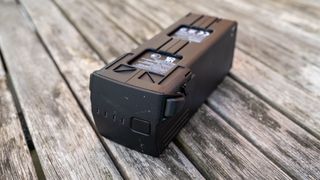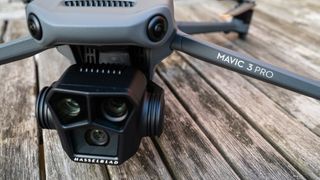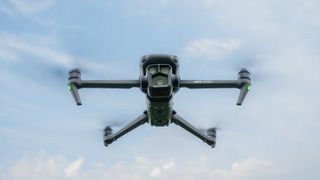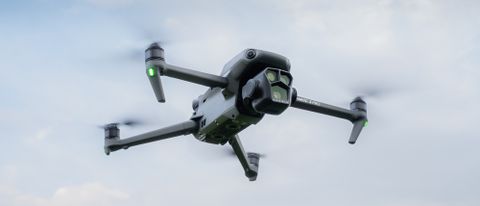Space Verdict
The DJI Mavic 3 Pro is one of the best foldable drones available. It offers impressive features and functionality, including three useful cameras, but it is expensive.
Pros
- +
Excellent image quality
- +
Up to 5.1K video capture
- +
3 useful cameras
Cons
- -
Expensive
- -
3 cameras may not be required
- -
C2 European classification
Why you can trust Space.com
Cameras: 20MP 4/3 main camera, 70 mm and 166 mm telephoto cameras
Video resolution: Up to 5.1K
Frame rates: 5.1K up to 75fps / 4K up to 120fps / FHD up to 200fps
Video transmission range: FPV Camera approx. 9.3 miles (FCC), 5 miles (CE/SRRC/MIC)
Flight modes: Sport, Normal, Cine
Battery: 5000 mAh / up to 43 minutes flight time
Charger type: USB-C: 5-20 V, max 5 A / Battery Charging Hub: 65 W
Weight: Mavic 3 Pro 33.79 oz/958 g, Mavic 3 Pro Cine 33.96 oz/963 g
Dimensions: 9.10 x 3.85 x 3.75 inches / 231.1 x 98 x 95.4 mm (folded)
13.68 x 11.44 x 4.24 inches / 347.5 x 290.8 x 107.7 mm (unfolded)
The rule of three in creativity suggests that three is more pleasing and interesting than two, for instance, and taking this idea into the technology realm is the DJI Mavic 3 Pro, the world’s first consumer drone to offer three cameras. With the main 24 mm Four Thirds camera taking center stage, it’s flanked by a 70 mm medium telephoto and a 166 mm telephoto that have the potential to open up even more creative possibilities, making it one of the best drones out there.
The Mavic 3 Pro shares the majority of its features and functionality with previous models including the single camera DJI Mavic 3 Classic and the original DJI Mavic 3 and Mavic 3 Cine with dual cameras. The main difference between both is the three cameras and the fact that the Mavic 3 Pro/Mavic 3 Pro Cine supersede the Mavic 3/Mavic 3 Cine, which are now unavailable on the DJI website.
What makes this new drone stand out is that the three cameras provide an incredible amount of versatility with the ability to maintain a consistent workflow when shooting with any of the cameras. The main camera is the excellent Four Thirds 20MP Hasselblad offering the most features and functionality, including an adjustable f/2.8-f/11 adjustable aperture. The 70 mm medium telephoto uses the same 1/1.3-inch sensor as the DJI Mini 3 Pro and the 166 mm telephoto features a 12MP 1/2-inch sensor.
Whether you’re an amateur or professional drone pilot, this is a drone that can easily meet your needs if you can make use of the three cameras on offer. While it’s not cheap, it does launch with a similar price as the Mavic 3 and Mavic 3 Cine. What this means is that you effectively get an additional 70 mm camera for free, and this is easily the best and most useful of the two telephotos.
DJI Mavic 3 Pro review: Design


- Excellent build quality & folding design
- Large 3 camera gimbal
- 2 smart controller options
Unmistakably a Mavic 3 series model, the Mavic 3 Pro features the signature Mavic folding design and looks almost identical to previous models. The only significant giveaway, apart from the name badge, is the larger gimbal that’s home to the three cameras with the two telephotos sitting above the main camera. Folded, the drone is 9.10 x 3.85 x 3.75 inches (231.1 x 98 x 95.4 mm) which extends to 13.68 x 11.44 x 4.24 (347.5 x 290.8 x 107.7 mm) unfolded.




It’s slightly larger and heavier than other Mavic 3 models at 33.79 oz/958 g for the 3 Pro and 33.96 oz/963 g for the 3 Pro Cine, which isn’t a problem for most regions around the world, but in the U.K. and mainland Europe, the drone has received a C2 rating. This simply means that the Mavic 3 Pro must be flown at least 50 m away from uninvolved people and 150 m away from built-up areas (although these distances can be reduced with certain drone qualifications).
The additional size and weight also mean that flight times have been slightly reduced compared to other models since it uses the same 5000 mAh batteries, with an advertised flight time of 43 minutes compared to 46 minutes. During testing, this difference was imperceptible with flight times averaging around the 30-minute mark like the other models we’ve tested.




There are two smart controller options available so no need for a smartphone, although the Mavic 3 Pro is compatible with the DJI RC-N1 controller. The Mavic 3 Pro Cine Premium Bundle is only available with the DJI RC Pro, but if you opt for the Mavic 3 Pro you can choose between this and the DJI RC which is the same smart controller that’s available with the Mavic Mini 3/3 Pro.
Both controllers feature 5.5-inch touchscreens with the RC Pro being slightly larger and heavier. The RC Pro provides up to four hours of battery life (compared to the other’s three hours) alongside a brighter screen, a stronger signal, and additional features, but it is more expensive. Both are excellent overall, so your budget will be a deciding factor as to which option you choose.
DJI Mavic 3 Pro review: Functionality



- Easy to fly for anyone
- ActiveTrack 5.0 subject tracking
- Omnidirectional collision avoidance
In flight, the controls are responsive with no perceivable lag between the controller and drone, with identical overall performance as other Mavic 3 models. There are three flight modes available. This includes Cine which is slower with reduced control sensitivity for smoother flight while recording video, Normal which is much faster and more responsive, and Sport which provides the fastest speed of up to 47 mph (note that in this mode obstacle avoidance is turned off so care is needed). Overall, it’s a powerful drone with a wind resistance speed of 27 mph.
Whether you’re an absolute beginner or a veteran drone pilot, the Mavic 3 Pro is incredibly intuitive and easy to fly as well as offering a host of flight and safety features. Precise positioning is delivered by connection to GPS, GLONASS, and BeiDou satellites with safety features including Advanced Return to Home which scans up to 200 m to determine the safest and most efficient route back to the take-off point. AirSense ADS-B provides notification of nearby planes and helicopters, while the GEO 2.0 geofencing system delivers information about restricted airspace and potential flight hazards.

The Omnidirectional Obstacle Sensing system utilizes Advanced Pilot Assistance System (APAS) 5.0 for collision avoidance, which analyses data from six fisheye sensors and two wide-angle sensors to sense obstacles in all directions. When enabled, the drone can be set to fly autonomously around obstacles when detected or to brake. The Bypass option also offers ‘Nifty’ mode which provides smoother flight in complex environments but with a higher collision risk, and it does work extremely well if you’re willing to take on that additional crash risk.
Then there are flight features including Cruise Control, Quickshots automated flight patterns for video, Mastershots, and Focus Track which includes ActiveTrack 5.0 and uses the omnidirectional obstacle sensors to improve subject tracking. However, this isn’t available when shooting video above 4K or frame at rates higher than 60fps. The Mavic 3 Pro uses the DJI 03+ transmission system that can transmit a 1080p/60fps live camera feed at a distance of up to 9.3 miles/15 km in the United States and up to 5 miles/8 km in other regions, although this is far beyond what is legal in most regions.
DJI Mavic 3 Pro review: Performance









- Excellent image quality for photos and videos
- 12-bit Raw and JPEG photos
- Video up to 5.1K
The Mavic 3 Pro’s main Hasselblad camera features a 20MP 4/3 sensor, an adjustable f/2.8-f/11 aperture, and a dynamic range of up to 12.8 stops with a 24 mm equivalent lens. Image quality for both photos and videos are excellent, and this will undoubtedly be the most used camera of the three available. The 70 mm and 166 mm cameras can also shoot photos in Raw and JPEG, as well as offering a sliding range of video features whereas the 166 mm offers the least video options but remains useful.
With the main Hasselblad camera, video resolution is available up to 5.1K in Normal, HLG (hybrid log-gamma high dynamic range), and 10-bit D-Log M profiles at 200Mbps. There are three Apple Pro Res options available offering a higher bitrate which is well suited to professional workflows. 5.1K can be shot at up to 50fps, DCI 4K (4096x2160 17:9 cinematic 4K) up to 120fps, 4K up to 120fps, and FHD up to 200fps.
Manual control is available for both telephoto cameras, except for the aperture which is fixed at f/2.8 for the 70 mm and f/3.4 for the 166 mm. The 70 mm uses a 1/1.3-inch sensor that’s capable of capturing photos at 12MP and 48MP and video in 4K and FHD up to 60fps in Normal, HLG, D-Log M, and three Apple ProRes formats. The 166 mm uses a 1/2-inch 12MP sensor and can capture video in 4K and FHD up to 60fps in the Normal color profile as well as the three Apple ProRes formats.
Out of the two, the 70 mm (which uses the same sensor as the Mavic Mini 3/3 Pro) provides better image quality, the most useful focal length, and improved video functionality. The 166 mm camera remains useful and there will be times when it’s the best option, but it would be great to see the more limited video formats increased in future firmware updates.



DJI Mavic 3 Pro review: Cost

Despite having three cameras rather than the two that were featured on the less impressive Mavic 3/Mavic 3 Cine, the Mavic 3 Pro models launch at a similar price as the older models they supersede, which is great news for consumers. However, it’s still an expensive drone that many people will struggle to justify, while those who can afford it will undoubtedly be pleased with their purchase because this is one of the best consumer drones available.
Mavic 3 Pro Kit options include the Mavic 3 Pro with the DJI RC for $2,199/£1,879, the DJI RC Fly More Bundle for $2,999/£2,549, the DJI RC Pro Fly More Bundle for $3,889/£3,169, and the Cine Premium Combo which costs $4,799/£4,109. The Fly More Bundles are great value and include two additional batteries, a carry bag, a charging hub, ND filters, and other useful accessories. Although owners of older Mavic 3 models may not need to invest in the Fly More Bundle options if they already own those additional accessories.
Should you buy the DJI Mavic 3 Pro?

The Mavic 3 Pro is the flagship model in a series of drones that straddle consumer and prosumer markets with a range of features that will satisfy the needs of both. Cost is always a significant deciding factor and whether or not you need, or will make use of, the additional two telephoto lenses is of equal importance.
If you’re looking for the best image quality, professional video features, and multiple cameras in a highly portable model, whether you’re an amateur drone pilot or professional, the Mavic 3 Pro will almost certainly meet your needs. However, if you don’t think you’ll get much use out of the 70 mm and 166 mm telephoto cameras, you might be better off saving some cash and opting for a different drone.
If the DJI Mavic 3 Pro isn't for you
If you’re unlikely to make use of the Mavic 3 Pro’s telephoto cameras, the logical option is to go for the DJI Mavic 3 Classic which only has the excellent 20MP Four Thirds Hasselblad camera with an adjustable aperture. Not only will you save a chunk of cash, but the Classic is marginally smaller and lighter while providing a slightly longer flight time. Check it out on the DJI website.
Medium-sized folding drones that weigh around 1.98 lbs/900 g may still be too large and heavy for people who typically carry photography/video kit alongside their drone. In this situation, a sub-250g model is the perfect option and the DJI Mavic 3 Pro is the best sub-250 g drone available with a range of useful features for beginners and professionals alike.
Or if you’re after something that costs a bit less but is still a powerful and fully featured drone, then the Autel EVO Lite+ is a great option. The Lite+ has a 1-inch sensor rather than a Four Thirds sensor though.
Join our Space Forums to keep talking space on the latest missions, night sky and more! And if you have a news tip, correction or comment, let us know at: community@space.com.
James is an award-winning freelance landscape and portrait photographer, as well as a highly experienced photography journalist working with some of the best photography magazines and websites with a worldwide audience. He’s also the author of The Digital Darkroom: The Definitive Guide to Photo Editing. www.jamesaphoto.co.uk
-
jerryway ReplyAdmin said:The DJI Mavic 3 Pro is the world’s first consumer drone featuring three cameras and provides a highly versatile option that comfortably straddles the consumer and prosumer markets.
DJI Mavic 3 Pro review : Read more
"Both controllers feature 5.5-inch touchscreens with the RC Pro being slightly larger and heavier. The RC Pro provides up to four hours of battery life (compared to the other’s three hours)"
- The weight of RC controller is 390g. RC Pro is 680g. It is not just "slightly heavier", it almost double the weight of RC. The battery life of RC Pro is also NOT four hours, but three hours instead. RC controller has four hours of battery life. You got it all mixed up here.

